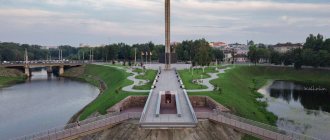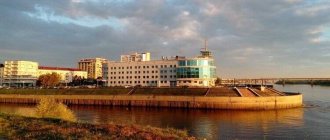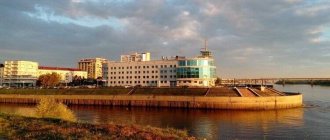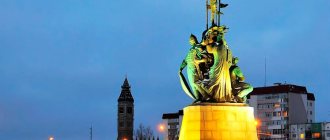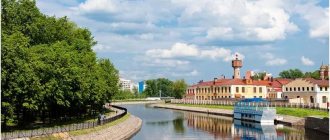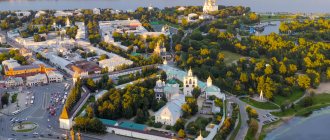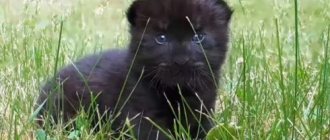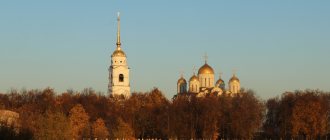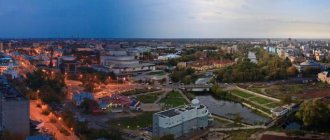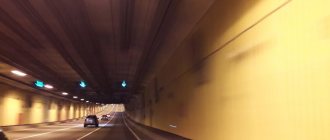Despite its industrial status, Ivanovo is one of the most interesting artistic centers in Russia. Ivanovo merchants-patrons D.G. made a huge contribution to the cultural and artistic life of the city. Burylin and Ya.P. Garelin. The city is actively developing long-standing theatrical and folk craft traditions. Ivanovo and the monuments of the Ivanovo region are less known than other cities of the Golden Ring, and yet there are many architectural ensembles from different eras: about 400 historical and architectural monuments are under state protection. Ivanovo continues to be the textile center of the country, for which it is called the “Russian Manchester”.
Among the main attractions of Ivanovo are architectural monuments in the constructivism style, an industrial and art museum and a chintz museum. Modern landscaped parks, city squares and the city's embankment are conducive to leisurely and pleasant walks.
1. Calico Museum
Address: st. Baturina, 11/42, Ivanovo
The very first place that a tourist should visit in Ivanovo is the local history museum. The exhibition “Ivanovo Textiles” presented there is the calling card of the city. Indeed, according to local residents and many researchers, it was here that the Russian weaving industry was born.
This part of the museum tells about the history of calico production and fashion of different eras. The exhibition introduces visitors to folk art objects: fabrics, fans, paintings, scarves. The attraction is located in an ancient building in the Art Nouveau style. The mansion has an interesting layout and is decorated with stained glass windows and decor. In 2013, a huge rhinoceros made of chintz was installed next to the museum.
Route
What to see in Ivanovo in 1 day? The tourist walk begins from Revolution Square . Next to it, tourists visit the Shchudrovskaya tent and then proceed to Pushkin Square . After crossing the Uvod River on the bridge, the route along Ivanovo will look like this: monuments of the Constructivist era - the residential buildings “Horseshoe” and “Ship” , followed by the Church of the Ascension of the Lord , Vvedensky Convent , the Duringer estate and the Church of the Transfiguration of the Lord .
Since Ivanovo is a rather large city, walking along the route will take most of the day. Along the route there are several museums, parks and public gardens where you can relax. The total length of the route is almost 10 km, the distance between some objects is 1.5–2 km or more. You can reduce your walking time by moving between attractions by taxi or public transport.
Embankment of the Uvod River Photo: © Valeria Belousova
Holy Vvedensky Monastery
Address: st. Basic, 23, Ivanovo
The Orthodox women's monastery, established in 1991, is located in the very center of the city. The church on its territory is an architectural monument of the 20th century. During the years of Soviet power, the city archive was located here, then believers fought long and hard for the restoration of the temple, even using a multi-day hunger strike.
Today this attraction of Ivanovo is open to visitors. The relics of saints are kept in one of the monastery churches. The nuns are actively involved in charitable and missionary activities, helping the sick, orphans, the homeless, the poor, the disabled and prisoners. The monastery has an “Orthodox helpline” and a publishing department where the local newspaper and various church literature are printed.
Transfiguration Cathedral Ivanovo
Address: st. Kolotilova, 44, Ivanovo
This beautiful ancient Ivanovo temple was built more than 120 years ago. The architecture of the White Church, as the townspeople lovingly called it, represents the “Russian” style that was fashionable at that time. In the 20th century, the cathedral was the only functioning church in the region. But despite this, the Orthodox church experienced destruction and closure, and many conflicts arose around it.
The work of the temple was resumed only in 1945, and a year later it received the status of a cathedral. Subsequently, a lengthy restoration was carried out. Currently, the cathedral is operational, it houses a Sunday school, a lecture hall, a women's choir, an Orthodox youth center and a temperance society. Parishioners help those in need, visit hospitals, orphanages, and colonies.
House-ship
House-ship
Ivanovo
As Vladimir Mayakovsky wrote in the twenties: “Moscow and Ivanovo... were built anew.”
An example of Soviet constructivism, this house is an integral symbol of Ivanovo. Architect Friedman turned a residential building for workers into a floating ship. One of the ends is shaped like the bow of a ship, and at the “stern” there is an observation tower.
Museum of the Soviet Automotive Industry
Address: st. Paris Commune, 16, Ivanovo
Visiting this attraction in Ivanovo will be interesting not only for men, but also for women and even children. The museum, opened in 2014, constantly hosts temporary thematic exhibitions. The guide will tell you about the history and development of the auto repair plant in Ivanovo.
The museum displays legendary cars from famous factories in the past: GAZ, ZIL, ZIS, ZIM, VAZ. The cars were donated by private individuals. Some of them are still in effect today. For example, GAZ21, its owner is the President of Russia.
In the museum’s souvenir shop you can purchase various thematic souvenirs as a keepsake of your visit, from a mug with a picture of a car to models of Soviet cars.
How to get there
Moscow — Ivanovo
The fastest way to get from Moscow to Ivanovo is by train: 3.5 hours. Schedule here .
It takes 5.5 hours to travel by bus from Moscow to Ivanovo. Bus schedule here
Since Ivanovo is located between Suzdal and Kostroma and is an intermediate point on the route of the classic Golden Ring, there is a bus service between these cities.
Vladimir - Ivanovo
By bus from Vladimir you can get to Ivanovo in an hour and a half. Schedule here
Suzdal — Ivanovo
You can leave Suzdal every hour; the bus will take about an hour. Schedule here .
Kostroma — Ivanovo
Buses from Ivanovo also go to Kostroma quite often. Travel time is 2.5 hours. Bus schedule
Ples - Ivanovo
Buses run frequently and travel time is approximately 2 hours. Bus schedule
Vologda — Ivanovo
Travel time from Vologda to Ivanovo by bus is almost 5 hours. Schedule
City embankment Ivanovo
The city embankment of the Uvodi River is a favorite vacation spot for local residents and city guests. Before the revolution, most of the local factories were located on the banks of the river, which polluted the reservoir with waste from their vital activity. People called the river “smelly” and even composed corresponding ditties about it.
The river that flows through the entire city is not suitable for swimming today, but it is quite suitable for a pleasant pastime. On the embankment you can feed ducks and seagulls, which is especially popular with children. Along the banks of the river there are various recreation areas, a square and a park.
Where to stay
If you decide to stay in Ivanovo to travel around the surrounding area and explore the city, then you need to decide what is more convenient for you: living in the center or near the bus station. If you travel around the region a lot, then the proximity of the bus station will be beneficial, and you can go to the center for half a day and not worry anymore.
If you want to combine business with pleasure, then you need to settle in the center. For example, the Onegin Hotel is located near the Uvod River and not far from that very picturesque view, in a 19th-century mansion, the rating is 8.5. Details here .
Or the four-star spa hotel Russian Manchester (that’s what Ivanovo is called, by the way) is located near the Shchudrovskaya tent, the rating is very good - 9.1. Look here
The three-star Soyuz Hotel also has a good rating - 8.9 and is located on the embankment, more details . All hotels on the map of Ivanovo:
Park of Culture and Leisure named after. V. Ya. Stepanova
Address: st. Smolnaya, 5, Ivanovo
This Ivanovo city park on the banks of the Uvodi River was opened in 1925. It received its name in honor of the revolutionary V. Ya. Stepanov. The park is famous for its archaeological finds. In 1959, ancient objects and tools were found on the territory of this attraction.
Nowadays it houses various entertainment attractions and is a family vacation spot. In the park you can play paintball, ride a bike or boat, or just stroll along the paths on foot. Popular folk holidays are often held here: City Day, Maslenitsa, Children's Day and others.
Attractions
In one day you are unlikely to be able to thoroughly explore all the surroundings, since there are many places for entertainment and cultural heritage. But if you plan your route wisely, you will be able to visit the most popular tourist spots, having a great rest and expanding your horizons.
Churches and cathedrals
Compared to other cities, there are much fewer monasteries here. Start your tour at the Cathedral of the Assumption of the Blessed Virgin Mary . The shrine appeared about 180 years ago. It was built in 1834. The construction was carried out according to the design of the architect E.Ya. Petrova. These were mainly funds from local manufacturers. The style of construction is late classicism.
The Kazan Church is located on the banks of the Uvodi. In its place there was once a calico-printing factory. It was led by Christian Liman. Mikhail Ivanovich Yamanovsky, as the head of the Old Believers community, having received ownership of the building, decided to build a church. The object, as conceived by the architect Maricelli, was distinguished by its laconic beauty and grandeur.
The Transfiguration Cathedral was founded in 1889. The construction process dragged on for four years. The budget of the manufacturer M.N. Garelin was used. The building is characterized by rich decoration. On the facades you can see kokoshniks and turrets. The octagon is equipped with five chapters, and the windows have elegant platbands. A tented bell tower is installed in the west. There are three entrances with porches.
The Temple of Elijah the Prophet has a close relationship with the history of the city. Once upon a time there was Ilyinskaya Sloboda near the village. The merchant Alexander Lepetov, well-known at that time, donated funds for the construction of the shrine. The building is designed in the style of Russian classicism. Porticoes with four columns are installed on the north and south. The bell tower is visible from the west.
The Church of the Icon of the Mother of God “Joy of All Who Sorrow” was built in 1821. At that time, the Shuya merchant Kornoukhov bought the territory from Count Vorontsov. Dmitrievskaya Sloboda appeared in this place. It bordered on Voznesenskaya, the sides were separated by a river.
The Church of the Vladimir Icon of the Mother of God is one of the main decorations of the city. The Ascension Convent, established here earlier, was considered the value of the Korin and Shcherbakov family. On the outskirts of the property there was the Alekseevskaya women's almshouse. On April 21, 1902, the first stone was laid for the Church of the Vladimir Icon. In 1904 the main altar was illuminated.
The Holy Vedensky Convent is a building in the neo-Byzantine style, considered the hallmark and pearl of the city. It delights with the unusual design. The monastery appeared in the 1990s. The number of nuns is 150 women. It also bears another name “Red Temple” because of the red brick as the main material. Pilgrims come here and excursions are held here.
Museums, monuments, architecture
Perhaps one of the most remarkable objects is the mysterious house-ship , made in the style of constructivism. The house amazes with its unusualness. It was built according to the design of D. Friedman. The architectural features combine two styles - symbolism and romanticism.
It's hard to pass by the horseshoe house . Hundreds of tourists stop here to take a couple of original photographs. The perspective from above is especially unusual. This was once a residential building. Employees of the state political department lived here. It was built in the 1930s. A distinctive feature is the original shape of a semicircle, which resembles a horseshoe. The customer wanted the building to be miniature and compact. As a result, today there is a spectacular building with six floors on the street, which is difficult to pass by without attention. The first floor is used for a store.
The Collective House is another object that is definitely worth a look. An interesting monument of constructivism consists of several buildings. This is a federal level landmark. Development of the project began back in 1920. We tried to implement the project of a communal house. The building is located on Fairgrounds. The buildings are connected to each other by retail space and other buildings. Initially, there was an idea for a corridor system. But then they decided to divide the space into sections. Each building is landscaped. All parts have a different number of floors. There is a cozy courtyard.
The art museum was only in plans for a long time. Military and revolutionary incidents delayed the start of construction. In the 1960s The long-awaited foundation of the exhibition center took place. The authorities found funds for the implementation of the project from the fund. The museum is located on Lenin Avenue 33.
There is a monument to the fighters of the revolution in the city. It is located in the square and was once considered the central attraction. The obelisk was installed in the 1970s. The design causes controversial views among residents. The monument consists of two elements. The central area has a triangular shape, symbolizing the prison casemates.
The Ivanovo Calico Museum is definitely worth a visit, because the entire history of the textile industry is closely intertwined with this place. Calico manufacturing is an important area of the industry. The exhibition was founded in the 1980s. The exhibitions feature antique and modern items. The guide will reveal the secret of the craftsmen’s work. The first exhibits were donated by D. Burylin. Gradually the exhibition began to expand and gained popularity.
The museum is organized in the native mansion of the famous collector. The building itself attracts the eye with its unusual architecture. The façade is elegant and has stained glass windows. This is how many rich houses of the 19th and 20th centuries were decorated. Walking through the halls, you will see Ivanovo calicoes, interesting ornaments, and get closer to the applied arts.
There is even an entire exhibition dedicated to Vyacheslav Zaitsev. The popular fashion designer was born in Ivanovo. By the way, if you use the pedestrian crossing, you will find yourself at another exhibition of industry and art. It is literally a few steps away.
The Museum of the First Fireworks will tell about the first council of workers' deputies in Russia. Once upon a time there was a town council in this building. It was built around 1904. Before this period, there was another ancient wooden building here. It was later changed to brick. In 1980, an exhibition was placed here. The object is located on Sovetskaya Street.
The embankment is a wonderful place for residents and tourists to relax. Walking along the picturesque lines of the Uvod River, you can enjoy the endless beauty. The walking part of the city is always lively, especially on warm days. In the pre-revolutionary period, the territory was given over to factories and factories. Soon the enterprises were moved to the outskirts. The coastal area has been improved. They planted trees, organized flower beds, benches, gazebos, and laid paths. This created a cozy relaxation area. There is a cinema "Lodz" nearby.
Park of Culture and Leisure named after. V. Ya. Stepanova is a popular recreation point for the population and all visitors. In the past, the land was owned by famous manufacturers - the Garelins. It was part of their domain. The park was laid out in a beautiful forest area, where there are many pines, spruces, and birches. Local residents still call it Garelinsky. Here you can relax in a shady area. There are various attractions for children, and there are pavilions with ice cream and cotton candy. On holidays, folk festivals and fairs take place.
Country holidays, camp sites
Outside the city there are many wonderful complexes where you can have a great time - go fishing, swim in a pond, ride a boat, organize a picnic, etc. The picturesque location of the spring area "Beavers", the park-hotel "Villa Fortecia", "Volzhskoye Compound", "Glazova Gora" are in high demand.
Vacationers love to come to the Ivanovo equestrian farmstead, to the remote recreation center "Mera", to the tourist complex "Peaceful Marina", the eco-estate "Rozhstvo", "Semigorye", "Sosnovy Bor".
If you love fresh air and artistic landscapes, then go to the Country Home eco-complex and the Yakimikha recreation center. For those who like fishing, the fishing base "Cape Verde" and the fishing and tourist base "Ershikha" are suitable.
Tourists are of great interest in the Holy Lake. You can get to the place in just 2.5 hours. It is convenient to cover the distance by car. A bus runs here from the city. Increased attention to the reservoir appeared in the last century.
The natural reservoir appeared as a result of the melting of ancient glaciers. The area is loved by vacationers because it gives peace and quiet. The lake is surrounded by pine forest, so there is rarely wind here. The water in the reservoir is warm and unusually clean. You can even see the sandstone bottom. It warms up to the very bottom. The total depth is 3.8 meters.
Flora and fauna are rich. This beautiful natural area is recognized as a protected area. There are many other bodies of water on the territory of Ivanovo. The largest lake is Rubskoye; the Lamenskoye or Bogoyavlenskoye and Zaborye reservoirs are rich in fish.
Shchudrovskaya tent
Address: st. 10 Augusta, 36a, Ivanovo
This oldest brick building in the city center is a unique object. It has national significance and is one of the main attractions of Ivanovo. The house was built at the end of the 17th century, in the valley of the Kokuy stream, as a hut for the administration of the village of Ivanovo. Later, 2 more floors were added.
What was not located here: workshops for the production of fabric with printed patterns, cotton wool production, warehouses, the premises were used as private housing. It was only in 1926 that the building was finally given the status of an architectural monument, after which restoration work was carried out, extra floors were dismantled and the roof was restored. Today it is part of the local history museum.
Hotels, restaurants, bars and cafes
Guests from Russia and foreign tourists often come to the city, so there will be no difficulties with where to spend the night. You can choose either a comfortable hotel in the center or an inexpensive option in a residential area. Popular hotels are “Gostinitsa Sova”, “Sosnovy Bor”, “Voznesenskaya”, “Tourist”, “Shaddock”, “Rai”, “Arta”, “Zubkovsky”, “Sputnik”, “Sabay” and many others.
Catering establishments are also represented in sufficient quantities. Business lunches and set lunches are popular. You can stop for a snack and have fun in such places as “Meeting”, “Russian Manchester”, “Chaika”, “Shesh-Besh”, “Seasons”, “GastroLi”, “Shakespeare”, “Pizza World”, etc. Popular shopping. "Poplar".
Dühringer Manor
Address: st. Maria Ryabinina, 33, Ivanovo
The Dühringer manor, which is over 100 years old, was built in the Art Nouveau style. It belonged to the Swiss Dühringer and resembled a medieval castle, as the owner himself wished when he ordered its construction. At that time, the lower floor of the main house was stone, and the 2nd floor was wooden. In addition to the main building, there were other buildings that have hardly survived to this day. There was a fountain in the courtyard, of which nothing remains either.
Here Dühringer first lived with his family; later the estate housed a military hospital, police headquarters, and a workers' club; the house was rebuilt many times. Now there are residential apartments inside, and the ancient building is in need of serious renovation. Many urban legends and superstitions are associated with this mysterious landmark of the city of Ivanovo.
Art Museum
Address: ave. Lenina, 33, Ivanovo
The Ivanovo Museum of Fine Arts was opened in 1959. Previously, this ancient building housed a school of colorists, a polytechnic institute, and a women's gymnasium. In front of the entrance to the museum there are two interesting sculptures: “Lyubava” and “Ariadne”.
The museum houses several private art collections (D. G. Burylin and other patrons), as well as works donated from the state fund. The museum's collections include objects of the ancient world, Eastern countries of the 18th-19th centuries, Western European art of the 16th-20th centuries, Russian art of the 16th-20th centuries. The departments of the art museum are the House-Museums of B.I. Prorokov and A.I. Morozova. This is a very interesting place to visit in Ivanovo.
Outskirts of Ivanovo
The southern part of the city, i.e. The original village of Ivanovo is divided into two parts by Lezhnevskaya Street. This is a large transport artery (buses No. 5, 14, trolleybuses No. 2, 7, 11, minibuses No. 7, 30, 37). Having passed through the private sector near the center, the street breaks out into the open space near the Lodz cinema (1966), where there is also a monument to the friendship of peoples and the Vladimir Church (1907). Further, after a few stops, there is a bus station. The south-eastern part of Ivanovo (Leninsky district) may be interesting only for the Transfiguration Cathedral (44 Kolotilova St.) and the Assumption Monastery (76 Smirnova St.) - there is an elegant blue church with a bell tower (1821, classicism, architect E.Ya. Petrov). From the southeast, Ivanovo is also adjacent to the city of Kokhma (founded in 1619, 28 thousand inhabitants) with several large factories, and intercity trolleybus No. 6 runs there. In the southwestern district of Ivanovo - Frunzensky - there is an energy institute (Rabfakovskaya St. , 34), where Timofeev and Ryzhov, members of the “Disco Accident” group, studied. You will pass it if you decide to visit the Ivanovo Zoo (Leningradskaya St., 2a) - 150 species of animals, many lynxes. From the bus station you can also take a commuter bus to the village of Novo-Talitsy (3 km west of Ivanovo), where the Tsvetaev family House-Museum is located (Tsvetaeva St., 63). This is a family estate where the family lived from 1853 to 1928. The house was built in the mid-19th century by priest Vladimir Tsvetaev, the grandfather of Marina and Anastasia.
The northwestern outskirts (Oktyabrsky district, from the station along Ermaka Street, trolleybus No. 4) are a student patrimony. First of all, this is IVSU (university, Ermaka St., 39), a little further - a large park named after. Stepanov with a beach on Uvodi, and just on the outskirts in Otradnoye you can find the longest electrified narrow-gauge railway in Russia, serving a silicate plant. The north-eastern district behind the railway (Sovetsky district, trolleybus No. 7 from the center) begins with the Krasnaya Talka memorial complex (1975) at the factory of the same name - an obelisk and the alley of heroes of the 1905 revolution, dedicated to the execution of the workers who held a rally, then there is a park named after the 1905 Revolution - a nice forest area with a pond where you can swim, and the building of the Interdom - an international orphanage, where in the 30s children of anti-fascists from other countries were raised and where, according to the will of the writer Gulya Koroleva, they were accepted as a pioneer (Sportivnaya St., 21, stop "28 th store").
What else to see in Ivanovo:
- Skating rink "Olympia"
Other cities of the Golden Ring:
|
|
Museum of History and Local Lore named after D.G. Burylina
Address: st. Baturina, 6/40, Ivanovo
When visiting the sights of Ivanovo, tourists should pay attention to the Museum of History and Local Lore named after D.G. Burylin, whose exhibits include ancient books, weapons, paintings, sculptures, coins, as well as cultural and everyday objects. The period from antiquity to modern times is represented here.
The main value of the museum is the private collection of books and coins of the Burylin family. The museum was founded in 1914 by the grandson of the famous manufacturer and philanthropist, Dmitry Burylin. But in 1919 the museum was nationalized and later became simply a local history museum. In 2003, a new life for the museum began; today it is a favorite place to visit for lovers of antiquity and scientists who study its exhibits with interest.
Let's sum it up
Unique museums with rich collections of rarities and antiquities and works of local folk crafts. Amazing architectural monuments: from Pre-Petrine Rus' to the Soviet avant-garde. Grandiose memorials and unusual monuments of modern times.
All this is Ivanovo, which is always ready to surprise its guests. You can and should come here for new impressions, mysterious legends, and a breath of history. This city is at the crossroads of eras; it contains a mixture of many different things: modernity, the conquests of the proletariat, folk crafts and ancient art. Everyone will choose what they like.
Revolution square
This is the central square of Ivanovo, where the main city buildings stand - the administration and the mayor's office. Lenin and Sheremetevsky avenues begin from here. Nearby is a popular place for folk festivals - Kokuy Boulevard. Previously, there were two churches and a chapel on the square, which were demolished in 1932.
Now in its center there is a landmark - a monument to revolutionaries, built in 1975, and right behind it there is a park. Opposite in 2011, a statue of Yakov Garelin was erected. In 2012, a chapel was built on the square.
Red Talca
Another important memorial in the history of the proletarian movement of Ivanovo-Voznesensk is the so-called Red Talka. At the end of the 19th and beginning of the 20th centuries, rallies and meetings of workers from local textile factories were buzzing and seething in this very place. The first monument in honor of those events appeared in 1957: a brick obelisk with an appropriate inscription. However, during the required reconstruction, it was completely rebuilt and received its current appearance. The new monument was opened in 1975. The authors of the composition are sculptor L. L. Mikhailyonok and architect V. S. Vasilkovsky.
Red Talca
Today, the memorial is an organic ensemble of several elements. The entrance to it is decorated with a small platform, which continues with a wide and long alley of heroes. At the beginning of it there is a monument to the Bolshevik Fyodor Afanasyev, who died on this place, and then on both sides there are busts of revolutionaries who took an active part in the First Russian Revolution. The compositional center of the memorial is an obelisk monument on a round platform, slightly elevated above the ground, in front of it is a bowl of eternal flame, now extinguished. In general, having lost its ideological significance, the “Red Talka” memorial has also lost state support, and therefore is in disrepair.
- Address: near the intersection of Shuvandina and Svoboda streets.
- Visiting hours: around the clock.
